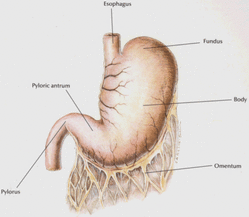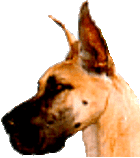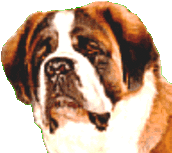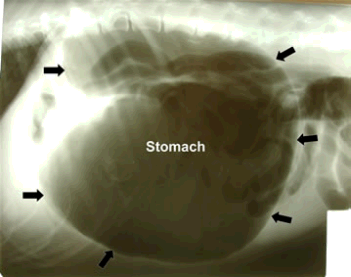MORE INFORMATION
HEALTH & WELLBEING
BLOAT: THE MOTHER OF ALL EMERGENCIES

There are many injuries and physical disorders which represent life-threatening emergencies. There is only one condition so drastic that it over shadows them all in terms of rapidity of consequences and effort in emergency treatment. This is the gastric dilatation and volvulus – the "bloat."
WHAT IS IT AND WHY IS IT SO SERIOUS?
The normal stomach sits high in the abdomen and contains a small amount of gas, some mucus, and any food being digested. It undergoes a normal rhythm of contraction, receiving food from the esophagus above, grinding the food, and meting the ground food out to the small intestine at its other end. Normally this proceeds uneventfully except for the occasional burp.
In the bloated stomach, gas and/or food stretches the stomach many times its normal size, causing tremendous abdominal pain. For reasons we do not fully understand, this grossly distended stomach has a tendency to rotate, thus twisting off not only its own blood supply but the only exit routes for the gas inside. Not only is this condition extremely painful but it is also rapidly life-threatening. A dog with a bloated, twisted stomach (more scientifically called "Gastric Dilatation and Volvulus") will die in pain in a matter of hours unless drastic steps are taken.
WHAT IS IT AND WHY IS IT SO SERIOUS?
The normal stomach sits high in the abdomen and contains a small amount of gas, some mucus, and any food being digested. It undergoes a normal rhythm of contraction, receiving food from the esophagus above, grinding the food, and meting the ground food out to the small intestine at its other end. Normally this proceeds uneventfully except for the occasional burp.
In the bloated stomach, gas and/or food stretches the stomach many times its normal size, causing tremendous abdominal pain. For reasons we do not fully understand, this grossly distended stomach has a tendency to rotate, thus twisting off not only its own blood supply but the only exit routes for the gas inside. Not only is this condition extremely painful but it is also rapidly life-threatening. A dog with a bloated, twisted stomach (more scientifically called "Gastric Dilatation and Volvulus") will die in pain in a matter of hours unless drastic steps are taken.
WHAT ARE THE RISK FACTORS FOR DEVELOPING BLOAT?
Classically, this condition affects dog breeds which are said to be "deep chested," meaning the length of their chest from backbone to sternum is relatively long while the chest width from right to left is narrow. Examples of deep chested breeds would be the Great Dane, Greyhound, and the setter breeds. Still, any dog can bloat, even dachshunds and chihuahuas.
Dogs weighing more than 99 pounds have an approximate 20% risk of bloat.
Classically also, the dog had eaten a large meal and exercised heavily shortly thereafter. Still, we usually do not know why a given dog bloats on an individual basis. No specific diet or dietary ingredient has been proven to be associated with bloat. Some factors found to increase and decrease the risk of bloat are listed below:
Factors Increasing the Risk of Bloating
· Feeding only one meal a day
· Having closely related family members with a history of bloat
· Eating rapidly
· Being thin or underweight
· Moistening dry foods (particularly if citric acid is listed as a preservative)
· Feeding from an elevated bowl
· Restricting water before and after meals
· Feeding a dry diet with animal fat listed in the first four ingredients
· Fearful or anxious temperament
· History of aggression towards people or other dogs
· Male dogs are more likely to bloat than females
· Older dogs (7 - 12 years) were the highest risk group
Factors Decreasing the Risk of Bloat
· Inclusion of canned dog food in the diet
· Inclusion of table scraps in the diet
· Happy or easy-going temperament
· Feeding a dry food containing a calcium-rich meat meal (such as meat/lamb meal, fish meal, chicken by-product meal, meat meal, or bone meal) listed in the first four ingredients of the ingredient list.
· Eating 2 or more meals per day
Contrary to popular belief, the presence of cereal ingredients such as soy, wheat or corn in the first four ingredients of the ingredient list does not increase the risk of bloat.
In a study done by the Perdue University Research Group, headed by Dr. Lawrence T. Glickman:
Classically, this condition affects dog breeds which are said to be "deep chested," meaning the length of their chest from backbone to sternum is relatively long while the chest width from right to left is narrow. Examples of deep chested breeds would be the Great Dane, Greyhound, and the setter breeds. Still, any dog can bloat, even dachshunds and chihuahuas.
Dogs weighing more than 99 pounds have an approximate 20% risk of bloat.
Classically also, the dog had eaten a large meal and exercised heavily shortly thereafter. Still, we usually do not know why a given dog bloats on an individual basis. No specific diet or dietary ingredient has been proven to be associated with bloat. Some factors found to increase and decrease the risk of bloat are listed below:
Factors Increasing the Risk of Bloating
· Feeding only one meal a day
· Having closely related family members with a history of bloat
· Eating rapidly
· Being thin or underweight
· Moistening dry foods (particularly if citric acid is listed as a preservative)
· Feeding from an elevated bowl
· Restricting water before and after meals
· Feeding a dry diet with animal fat listed in the first four ingredients
· Fearful or anxious temperament
· History of aggression towards people or other dogs
· Male dogs are more likely to bloat than females
· Older dogs (7 - 12 years) were the highest risk group
Factors Decreasing the Risk of Bloat
· Inclusion of canned dog food in the diet
· Inclusion of table scraps in the diet
· Happy or easy-going temperament
· Feeding a dry food containing a calcium-rich meat meal (such as meat/lamb meal, fish meal, chicken by-product meal, meat meal, or bone meal) listed in the first four ingredients of the ingredient list.
· Eating 2 or more meals per day
Contrary to popular belief, the presence of cereal ingredients such as soy, wheat or corn in the first four ingredients of the ingredient list does not increase the risk of bloat.
In a study done by the Perdue University Research Group, headed by Dr. Lawrence T. Glickman:
A study by Ward, Patonek, and Glickman reviewed the benefit of prophylactic surgery for bloat. Prophylactic surgery amounts to performing the gastropexy surgery (see below) in a healthy dog, usually in conjunction with spay or neuter. The lifetime risk of death from bloat was calculated, along with estimated treatment for bloat, versus cost of prophylactic gastropexy. Prophylactic gastropexy was found to make sense for at-risk breeds, especially the Great Dane, which is at highest risk for bloat.
HOW TO TELL IF YOUR DOG HAS BLOATED
The dog may have an obviously distended stomach especially near the ribs but this is not always evident depending on the dog's body configuration.
The biggest clue is the vomiting: the pet appears highly nauseated and is retching but little is coming up.
If this is seen, rush your dog to the veterinarian IMMEDIATELY.
WHAT HAS TO BE DONE
There are several steps to saving a bloated dogs life. Part of the problem is that all steps should be done at the same time and as quickly as
possible.
FIRST: THE STOMACH MUST BE DECOMPRESSED
The huge stomach is by now pressing on the major blood vessels carrying blood back to the heart. This stops normal circulation and sends the
dog into shock. Making matters worse, the stomach tissue is dying because it is stretched too tightly to allow blood circulation through it. There can be no recovery until the stomach is untwisted and the gas released. A stomach tube and stomach pump are generally used for this but sometimes surgery is needed to achieve stomach decompression.
ALSO FIRST: RAPID IV FLUIDS MUST BE GIVEN TO REVERSE THE SHOCK
Intravenous catheters are placed and life-giving fluid solutions are rushed in to replace the blood that cannot get past the bloated stomach to return to the heart. The intense pain associated with this disease causes the heart rate to race at such a high rate that heart failure will result. Medication to resolve the pain is needed if the patient’s heart rate is to slow down. Medication for shock, antibiotics and electrolytes are all vital in stabilizing the patient.
ALSO FIRST: THE HEART RHYTHM IS ASSESSED AND STABILIZED
There is a special very dangerous rhythm problem, called a "premature ventricular contraction" or "pvc," associated with bloat and it must be ruled out. If it is present, intravenous medications are needed to stabilize the rhythm. Since this rhythm problem may not be evident until even the next day continual EKG monitoring may be necessary. Disturbed heart rhythm already present at the beginning of treatment is associated with a 38% mortality rate.
Getting the bloated dog's stomach decompressed and reversing the shock is an adventure in itself but the work is not yet half finished.
SURGERY
All bloated dogs, once stable, should have surgery. Without surgery, the damage done inside cannot be assessed or repaired plus bloat may
recur at any point, even within the next few hours and the above adventure must be repeated. Surgery, called gastropexy, allows the stomach to be tacked into normal position so that it may never again twist. Without gastropexy, the recurrence rate of bloat may be as high as 75%!
Assessment of the internal damage is also very important to recovery. If there is a section of dying tissue on the stomach wall, this must be discovered and removed or the dog will die despite the heroics described above. Also, the spleen, which is located adjacent to the stomach may twist with the stomach. The spleen may require removal, too.
If the tissue damage is so bad that part of the stomach must be removed, the mortality rate jumps to 28 - 38%.
If the tissue damage is so bad that the spleen must be removed, the mortality rate is 32 - 38%.
After the expense and effort of the stomach decompression, it is tempting to forgo the further expense of surgery. However, consider that the
next time your dog bloats, you may not be there to catch it in time and, according the study described below, without surgery there is a 24%
mortality rate and a 76% chance of re-bloating at some point. The best choice is to finish the treatment that has been started and have the abdomen explored. If the stomach can be surgically tacked into place, recurrence rate drops to 6%.
RESULTS OF A STATISTICAL STUDY
In 1993, a statistical study involving 134 dogs with gastric dilatation and volvulus was conducted by the School of Veterinary Medicine in
Hanover, Germany.
Out of 134 dogs that came into the hospital with this condition:
· 10% died or were euthanized prior to surgery (factors involved included expense of treatment, severity/advancement of disease etc.)
· 33 dogs were treated with decompression and no surgery. Of these dogs, 8 (24%) died or were euthanized within the next 48 hours due to poor response to treatment. (Six of these 8 had actually re-bloated)
· Of the dogs that did not have surgical treatment but did survive to go home, 76% had another episode of gastric dilatation and volvulus eventually.
· 88 dogs were treated with both decompression and surgery. Of these dogs, 10% (9 dogs) died in surgery, 18% (16 dogs) died in the week after surgery, 71.5% (63 dogs) went home in good condition. Of the dogs that went home in good condition, 6% (4 dogs) had a second episode of bloat later in life.
· In this study 66.4% of the bloated dogs were male and 33.6% were female. Most dogs were between ages 7 and 12 years old. The German Shepherd dog and the Boxer appeared to have a greater risk for bloating than did other breeds.
Meyer-Lindenberg A., Harder A., Fehr M., Luerssen D., Brunnberg L. Treatment of gastric dilatation-volvulus and a rapid method for prevention of relapse in dogs: 134 cases (1988-1991) Journal of the AVMA, Vol 23, No 9, Nov 1 1993, 1301-1307. Another study published December of 2006 looked at 166 dogs that received surgery for gastric dilatation and volvulus. The point of the study was to identify factors that led to poor prognosis.
· A 16.2% mortality rate was observed. The mortality rate for dogs over age 10 years was 21%.
· Of the 166 going to surgery, 4.8% were euthanized during surgery, and the other 11.4% died during hospitalization (2 of dogs died during surgery). All dogs that survived to go home were still alive at the time of suture removal.
· 34 out of 166 dogs had gastric necrosis (dead stomach tissue which had to be removed). Of these dogs 26% died or were euthanized.
· Post-operative complications of some sort occured in 75.9% of patients. Approximately 50% of these dogs developed a cardiac arrhythmia.
· Risk factors significantly associated with death prior to suture removal included clinical signs of bloating for greater than 6 hours before seeing the vet, partial stomach removal combined with spleen removal, need for blood transfusion, low blood pressure at any time during hospitalization, sepsis (blood infection, and peritonitis (infection of the abdominal membranes).
(Beck, J.J., Staatz, A.J., Pelsue, D.H., Kudnig, S.T., MacPhail, C.M., Seim H.B, and Monnet, E. Risk factors associated with short-term outcome and development of perioperative complications in dogs undergoing surgery because of gastric dilatation-volvulus: 166 cases (1992-2003). Journal of the AVMA, Vol 229, No 12, December 15, 2006, p 1934-1939.)
NOTE:
It is crucially important that the owners of St Bernards are aware of this condition and are prepared for it. Know where to take your dog during night, Sunday and after hours for emergency care. Avoid exercising your dog after a large meal. Know what to watch for. Enjoy the special friendship a large dog provides but at the same time be aware of the large dog's special needs and issues.
There are several steps to saving a bloated dogs life. Part of the problem is that all steps should be done at the same time and as quickly as
possible.
FIRST: THE STOMACH MUST BE DECOMPRESSED
The huge stomach is by now pressing on the major blood vessels carrying blood back to the heart. This stops normal circulation and sends the
dog into shock. Making matters worse, the stomach tissue is dying because it is stretched too tightly to allow blood circulation through it. There can be no recovery until the stomach is untwisted and the gas released. A stomach tube and stomach pump are generally used for this but sometimes surgery is needed to achieve stomach decompression.
ALSO FIRST: RAPID IV FLUIDS MUST BE GIVEN TO REVERSE THE SHOCK
Intravenous catheters are placed and life-giving fluid solutions are rushed in to replace the blood that cannot get past the bloated stomach to return to the heart. The intense pain associated with this disease causes the heart rate to race at such a high rate that heart failure will result. Medication to resolve the pain is needed if the patient’s heart rate is to slow down. Medication for shock, antibiotics and electrolytes are all vital in stabilizing the patient.
ALSO FIRST: THE HEART RHYTHM IS ASSESSED AND STABILIZED
There is a special very dangerous rhythm problem, called a "premature ventricular contraction" or "pvc," associated with bloat and it must be ruled out. If it is present, intravenous medications are needed to stabilize the rhythm. Since this rhythm problem may not be evident until even the next day continual EKG monitoring may be necessary. Disturbed heart rhythm already present at the beginning of treatment is associated with a 38% mortality rate.
Getting the bloated dog's stomach decompressed and reversing the shock is an adventure in itself but the work is not yet half finished.
SURGERY
All bloated dogs, once stable, should have surgery. Without surgery, the damage done inside cannot be assessed or repaired plus bloat may
recur at any point, even within the next few hours and the above adventure must be repeated. Surgery, called gastropexy, allows the stomach to be tacked into normal position so that it may never again twist. Without gastropexy, the recurrence rate of bloat may be as high as 75%!
Assessment of the internal damage is also very important to recovery. If there is a section of dying tissue on the stomach wall, this must be discovered and removed or the dog will die despite the heroics described above. Also, the spleen, which is located adjacent to the stomach may twist with the stomach. The spleen may require removal, too.
If the tissue damage is so bad that part of the stomach must be removed, the mortality rate jumps to 28 - 38%.
If the tissue damage is so bad that the spleen must be removed, the mortality rate is 32 - 38%.
After the expense and effort of the stomach decompression, it is tempting to forgo the further expense of surgery. However, consider that the
next time your dog bloats, you may not be there to catch it in time and, according the study described below, without surgery there is a 24%
mortality rate and a 76% chance of re-bloating at some point. The best choice is to finish the treatment that has been started and have the abdomen explored. If the stomach can be surgically tacked into place, recurrence rate drops to 6%.
RESULTS OF A STATISTICAL STUDY
In 1993, a statistical study involving 134 dogs with gastric dilatation and volvulus was conducted by the School of Veterinary Medicine in
Hanover, Germany.
Out of 134 dogs that came into the hospital with this condition:
· 10% died or were euthanized prior to surgery (factors involved included expense of treatment, severity/advancement of disease etc.)
· 33 dogs were treated with decompression and no surgery. Of these dogs, 8 (24%) died or were euthanized within the next 48 hours due to poor response to treatment. (Six of these 8 had actually re-bloated)
· Of the dogs that did not have surgical treatment but did survive to go home, 76% had another episode of gastric dilatation and volvulus eventually.
· 88 dogs were treated with both decompression and surgery. Of these dogs, 10% (9 dogs) died in surgery, 18% (16 dogs) died in the week after surgery, 71.5% (63 dogs) went home in good condition. Of the dogs that went home in good condition, 6% (4 dogs) had a second episode of bloat later in life.
· In this study 66.4% of the bloated dogs were male and 33.6% were female. Most dogs were between ages 7 and 12 years old. The German Shepherd dog and the Boxer appeared to have a greater risk for bloating than did other breeds.
Meyer-Lindenberg A., Harder A., Fehr M., Luerssen D., Brunnberg L. Treatment of gastric dilatation-volvulus and a rapid method for prevention of relapse in dogs: 134 cases (1988-1991) Journal of the AVMA, Vol 23, No 9, Nov 1 1993, 1301-1307. Another study published December of 2006 looked at 166 dogs that received surgery for gastric dilatation and volvulus. The point of the study was to identify factors that led to poor prognosis.
· A 16.2% mortality rate was observed. The mortality rate for dogs over age 10 years was 21%.
· Of the 166 going to surgery, 4.8% were euthanized during surgery, and the other 11.4% died during hospitalization (2 of dogs died during surgery). All dogs that survived to go home were still alive at the time of suture removal.
· 34 out of 166 dogs had gastric necrosis (dead stomach tissue which had to be removed). Of these dogs 26% died or were euthanized.
· Post-operative complications of some sort occured in 75.9% of patients. Approximately 50% of these dogs developed a cardiac arrhythmia.
· Risk factors significantly associated with death prior to suture removal included clinical signs of bloating for greater than 6 hours before seeing the vet, partial stomach removal combined with spleen removal, need for blood transfusion, low blood pressure at any time during hospitalization, sepsis (blood infection, and peritonitis (infection of the abdominal membranes).
(Beck, J.J., Staatz, A.J., Pelsue, D.H., Kudnig, S.T., MacPhail, C.M., Seim H.B, and Monnet, E. Risk factors associated with short-term outcome and development of perioperative complications in dogs undergoing surgery because of gastric dilatation-volvulus: 166 cases (1992-2003). Journal of the AVMA, Vol 229, No 12, December 15, 2006, p 1934-1939.)
NOTE:
It is crucially important that the owners of St Bernards are aware of this condition and are prepared for it. Know where to take your dog during night, Sunday and after hours for emergency care. Avoid exercising your dog after a large meal. Know what to watch for. Enjoy the special friendship a large dog provides but at the same time be aware of the large dog's special needs and issues.
HIP & ELBOW SCORING
Responsible breeders always hip and elbow score their breeding stock. The Australian Veterinary Association (AVA) has a scoring scheme that is Australia wide with averages produced for each breed. Ideally breeders should only breed from stock that is at or below the breed average.
The average hip score for Saint Bernards in 1991 was 21.2 and at that time the Club suggested a combined mating total for both dog and bitch of 45 with neither dog or bitch being in excess of 30 as a guideline. The average hip score for the breed published in the Canine Hip and Elbow Dysplasia Scheme March 2011 was 16.1. This average has increased to 17.1 in 2013 as advised by the Australian Veterinary Association July 2013.
Scoring is done on 9 different points of the hip joint anatomy and each area (apart from the caudal acetabular edge which is out of 5) is scored out of a possible 6 points. The lower the score, the better the hips. The maximum score per hip is 53, with an overall total of 106. The score is usually expressed as e.g. 0/3, where the first figure is the total score achieved in the right hip and the latter in the left. A score of 51/48 would indicate that both hips are severely dysplastic.
There are three common forms of elbow disease. The current protocol for elbow scoring assesses the presence of arthrosis and readily identifies ununited anconeal process (UAP) but only rarely identifies fragmented medial coroniod process (FCP) and osteochondrosis of the medial condyle of the humerus (OCD). The scoring system is as follows: Nil Arthrosis = Grade 0; Minimal Arthrosis = Grade 1; Moderate Arthrosis = Grade 2; and Severe Arthrosis = Grade 3. Therefore the lower the score the better.
The suggested age for x-ray examination is 12-18 months, when both hips and elbows can be done at the same time. X-rays are taken by a qualified vet and are sent into AVA for grading after which you receive back a certificate with an assessment.
Links: http://www.online-vets.com/hipscore_5.html
- This information has been taken from the Club's Breed Information Book First Printed in May 2002
The average hip score for Saint Bernards in 1991 was 21.2 and at that time the Club suggested a combined mating total for both dog and bitch of 45 with neither dog or bitch being in excess of 30 as a guideline. The average hip score for the breed published in the Canine Hip and Elbow Dysplasia Scheme March 2011 was 16.1. This average has increased to 17.1 in 2013 as advised by the Australian Veterinary Association July 2013.
Scoring is done on 9 different points of the hip joint anatomy and each area (apart from the caudal acetabular edge which is out of 5) is scored out of a possible 6 points. The lower the score, the better the hips. The maximum score per hip is 53, with an overall total of 106. The score is usually expressed as e.g. 0/3, where the first figure is the total score achieved in the right hip and the latter in the left. A score of 51/48 would indicate that both hips are severely dysplastic.
There are three common forms of elbow disease. The current protocol for elbow scoring assesses the presence of arthrosis and readily identifies ununited anconeal process (UAP) but only rarely identifies fragmented medial coroniod process (FCP) and osteochondrosis of the medial condyle of the humerus (OCD). The scoring system is as follows: Nil Arthrosis = Grade 0; Minimal Arthrosis = Grade 1; Moderate Arthrosis = Grade 2; and Severe Arthrosis = Grade 3. Therefore the lower the score the better.
The suggested age for x-ray examination is 12-18 months, when both hips and elbows can be done at the same time. X-rays are taken by a qualified vet and are sent into AVA for grading after which you receive back a certificate with an assessment.
Links: http://www.online-vets.com/hipscore_5.html
- This information has been taken from the Club's Breed Information Book First Printed in May 2002
EXPORTING
At the Australian national Kennel Council conference held 18-20th October 2001, the Delegates resolved the following:
1.6 Exportation of Dogs
It was resolved that no person being a Member of any ANKC Member Body, shall knowingly sell a pedigree dog/bitch to any person residing in an overseas country known to be involved in the utilisation of dogs for the meat trade, without first satisfying the affiliate body that the purchaser is of good character and is a Member of the appropriate Canine Kennel Council or Canine Association in the country of import (as recognised by the ANKC). The seller and purchaser further acknowledge that the export dog/bitch is being sold with the intention of showing and/or breeding with the intent to improve the quality of that breed in that country and not for any other purpose.
Breeders genuinely concerned for the welfare and wellbeing of the breed, will ensure the humane treatment of their dogs by shipping only to individual parties, by shipping puppies in safe, comfortable enclosures with adequate ventilation, and never ship puppies under eight weeks of age.
1.6 Exportation of Dogs
It was resolved that no person being a Member of any ANKC Member Body, shall knowingly sell a pedigree dog/bitch to any person residing in an overseas country known to be involved in the utilisation of dogs for the meat trade, without first satisfying the affiliate body that the purchaser is of good character and is a Member of the appropriate Canine Kennel Council or Canine Association in the country of import (as recognised by the ANKC). The seller and purchaser further acknowledge that the export dog/bitch is being sold with the intention of showing and/or breeding with the intent to improve the quality of that breed in that country and not for any other purpose.
Breeders genuinely concerned for the welfare and wellbeing of the breed, will ensure the humane treatment of their dogs by shipping only to individual parties, by shipping puppies in safe, comfortable enclosures with adequate ventilation, and never ship puppies under eight weeks of age.




